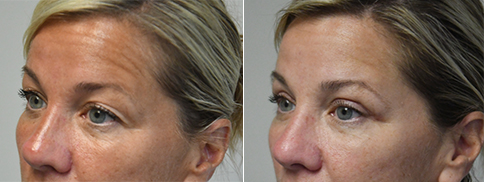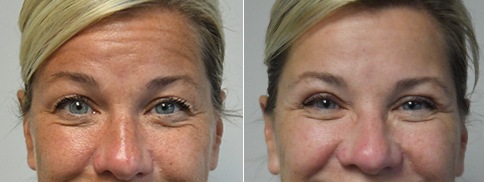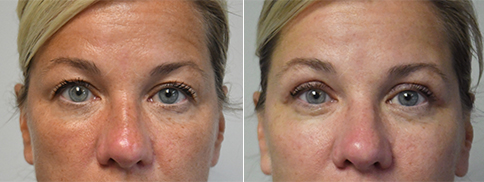What is Blepharoplasty?
Blepharoplasty, or eyelid surgery, in Boston and Worcester, Massachusetts, is performed to improve the issue of excess sagging skin on the upper or lower eyelids. Under-eye puffiness and bags may also be addressed, which can often lead to patients looking older or more tired than they are. For most patients wishing to correct irregularities surrounding their eyes, blepharoplasty may be the ideal solution.
Am I a good candidate for Blepharoplasty?
Eyelid surgery is suitable for both men and women who are physically healthy, psychologically stable and realistic in their expectations of the procedure. Typically, patients opting to undergo eyelid surgery are thirty five years or older, although for patients with sagging eyelids that are hereditary it may be performed at an earlier age. It should be noted that individuals with serious eye conditions or that smoke may not be candidates for eyelid surgery.
Blepharoplasty Patient #19
A woman in her mid-50s with brow ptosis ( deflation and descent of the brows from aging) as well as excess skin on her upper eyelids. She is shown before and again, 6 weeks after bilateral upper eyelid blepharoplasty combined with browpexy.
Discussion: As we age our tissues deflate and our brow drops. She is seen to have transverse forehead lines at rest as she works to hold her eyebrows out of the way with her frontalis muscles. Although she could consider a brow lift, she elevated for a simpler brow pexy- this does not elevate the brows but prevents them from dropping further. It is done through the blepharoplasty procedure. After surgery, we can see that her forehead lines are relaxed as she no longer has to work unconsciously to hold her eyebrows up. Scars are at their pinkest at 6 weeks and will begin to fade and improve over the next 6 months or longer. Her appearance is “refreshed” in a natural way and she no longer has problems with her upper visual field being blocked by the excess skin.
Blepharoplasty (Eyelid Surgery) #18
A woman in her later 60s was shown before and again, 5 months after an anterior hairline brow lift, upper and lower eyelid blepharoplasty, and fat grafting to the mid-face.
Discussion: She has significant brow ptosis but a high forehead. If a traditional brow lift had been performed it would have pulled her hairline back and appeared even more unnatural. Instead, an anterior hairline or “pretrichial” incision is used. It is actually beveled and made in a wavy fashion so that the hairs grow up through the incision and help to camouflage it. This actually lowers the hairline, making it more aesthetic and at the same time, it eliminates the heaviness of the eyebrows and smooths the forehead lines that are more prominent as the patient constantly activates the frontalis muscle to hold the brows up.
Some excess skin is taken out of the upper eyelids at the same time( upper eyelid blepharoplasty). Blepharoplasty of the upper lid alone would not have looked as natural because it would not address the heaviness of the eyebrows from aging ( “brow ptosis”)
The lower eyelids can be the most challenging because she has a combination of prominent fat pads which were reduced here through the eyelid (transconjunctival approach”) but then just a small pinch of skin was excised to avoid pulling the lower eyelids down, and the volume loss from aging that gave a hollow look was corrected with fat grafting. The combined result gives her a rested and refreshed but natural appearance.
Blepharoplasty Patient 16
A woman in her later 50’s who has some obstruction of her upper vision by excess upper eyelid skin and brow ptosis (age-related drooping of the eyebrows)
She is shown before and again 3 ½ months after bilateral upper eyelid blepharoplasty combined with browpexy. With a brow “pexy,” the eyebrow are fixed to the orbital septum so they don’t drop further when the patient stands up. . They are not elevated as in a brow lift but it is a simpler procedure that some patients prefer.
Blepharoplasty – Patient 125
A woman in her mid 60’s whose vision was blocked by excess skin of her upper eyelids and drooping of the eye brows. She is shown before and again, 6 weeks after an upper eyelid blepharoplasty combined with a brow-pexy. ( “pexy” means “to fix in position” ) A brow lift would have decreased forehead lines and improved the aesthetic appearance more by elevating the brow. But a brow lift is considered cosmetic and not covered by insurance. She elected for a brow-pexy at the time of her blepharoplasty, which does not elevate the brows but fixes them to prevent them from dropping more when a patient sits up. As people age we lose volume in the face and the brows descend, contributing to lateral “hooding” of the brows. Her goal was to improve her blocked vision rather than to maximally improve her appearance
Blepharoplasty – Patient 124
A woman in her early 70’s whose vision was blocked by excess skin of her upper eyelids and drooping of the eye brows. She is shown before and again, 6 weeks after an upper eyelid blepharoplasty combined with a brow-pexy. A brow lift would have decreased forehead lines and improved the aesthetic appearance more by elevating the brow. But a brow lift is considered cosmetic and not covered by insurance. She elected for a brow-pexy at the time of her blepharoplasty, which does not elevate the brows but fixes them to prevent them from dropping more when a patient sits up. As people age we lose volume in the face and the brows descend, contributing to lateral “hooding” of the brows. Her goal was to improve her blocked vision rather than to maximally improve her appearance
Frequently Asked Questions About Blepharoplasty
How is Blepharoplasty done?
Blepharoplasty is completed in about an hour with the help of a local anesthetic. During surgery, any unwanted excess skin will be removed. Incisions are closed with removable sutures, skin adhesives, or surgical tape.
Will I have any scars?
Eyelid surgery incisions are generally placed in a location where the scars will be concealed within the natural configuration of the eyelid. Therefore, scars from eyelid surgery are not regularly visible.
What should I expect during recovery?
During eyelid surgery recovery, patients may experience light bruising, swelling, or irritation to the eyes. Any discomfort is aided with pain medication, ointment, or cold compresses. Recovery time will vary, but everyday activities can normally be resumed after 10 days. It is also imperative that patients avoid direct sunlight to the eye area until the healing process is complete. Dr. Hall will provide you with specific instructions to ensure a safe and quick recovery.
How long will results last?
Results from both upper and lower blepharoplasty are long lasting. Once fat and excess skin are removed from the lower eyelid or under the eye, it will not regenerate.

“I saw 3 surgeons before meeting with Dr. Hall and by far he and his staff was the most compassionate, thorough, professional and helpful. Can’t say how pleased and comfortable he and his staff made me feel.”
Real Patient Ratings™ Review










Cosmetic & Plastic Surgery Specialist
"I treat my patients like I would treat
- Jonathan D. Hall, MD, FACSmembers of my own family."
Schedule Consultation